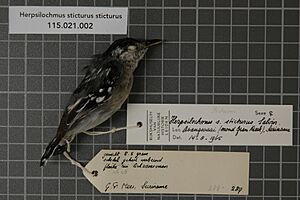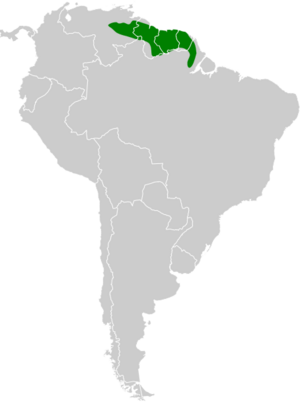Spot-tailed antwren facts for kids
Quick facts for kids Spot-tailed antwren |
|
|---|---|
 |
|
| Conservation status | |
| Scientific classification | |
| Genus: |
Herpsilochmus
|
| Species: |
sticturus
|
 |
|
The spot-tailed antwren (Herpsilochmus sticturus) is a small bird that belongs to the "typical antbirds" family. You can find it in countries like Brazil, French Guiana, Guyana, Suriname, and Venezuela.
Contents
About This Bird
The spot-tailed antwren was once thought to be the same species as Dugand's antwren. Now, scientists know they are different but very closely related. This bird is the only member of its specific group, meaning it doesn't have any subspecies.
What Does It Look Like?
The spot-tailed antwren is about 9.5 to 10.5 centimeters (3.7 to 4.1 inches) long. It weighs around 8 to 9 grams (0.28 to 0.32 ounces).
Male Birds
Adult males have a black cap on their head and a black neck. They have a long, light gray or white stripe above their eye. A black stripe goes through their eye, and their cheek feathers are light gray. Their back and rump are dark gray with black spots. They have white-edged black feathers on their shoulders and a white patch between their shoulder blades. Their wings are black with white tips on some feathers and white edges on the flight feathers. Their tail is black with white tips and a long white stripe on the middle feathers. Their throat and belly are light gray, with a white center on the belly.
Female Birds
Adult females have a black cap with reddish-brown stripes. Their flight feathers have buff-colored (pale yellowish-brown) edges. Their underparts are lighter and have a buffy tint compared to the males.
Where It Lives
You can find the spot-tailed antwren in eastern Venezuela, across the Guianas (French Guiana, Guyana, Suriname), and into northeastern Brazil. It lives in the middle and upper parts of humid evergreen forests. These birds often prefer areas near water, like forests along rivers or forests that get flooded sometimes. In these places, they like to hang out in thick tangles of vines.
Bird Behavior
Movement
Scientists believe that the spot-tailed antwren stays in the same area all year round. It does not migrate to other places.
Feeding Habits
We don't know all the details about what the spot-tailed antwren eats. However, we do know it mostly eats arthropods, which are creatures like insects and spiders. This bird often looks for food alone, in pairs, or with its family. It also frequently joins groups of different bird species that are feeding together. It usually searches for food high up in the trees, between 15 and 30 meters (49 and 98 feet) above the ground. It moves actively and catches its prey by picking it off leaves, stems, and vines while perched.
Reproduction
We know very little about how spot-tailed antwrens raise their young. One group of young birds in French Guiana left the nest in October. More research is needed to learn about their breeding habits.
Bird Calls
The spot-tailed antwren's song is a short, very high, quick series of notes that then turns into a rattling sound. The first few notes of its song go up slightly in pitch. Its calls include a repeated, sharp, downward-sloping "chut" sound. It also makes a sudden, quiet whistling sound that mostly goes up in pitch.
Conservation Status
The IUCN (International Union for Conservation of Nature) says the spot-tailed antwren is a species of "Least Concern." This means it is not currently in danger of disappearing. It lives across a large area, and its population size is thought to be stable. There are no immediate threats to this bird. It is considered uncommon to fairly common in the places where it lives. It can be found in several large protected areas. It also lives in big areas of untouched forest that are not officially protected but seem safe from development for now. However, this bird is thought to be very sensitive to human activity.


